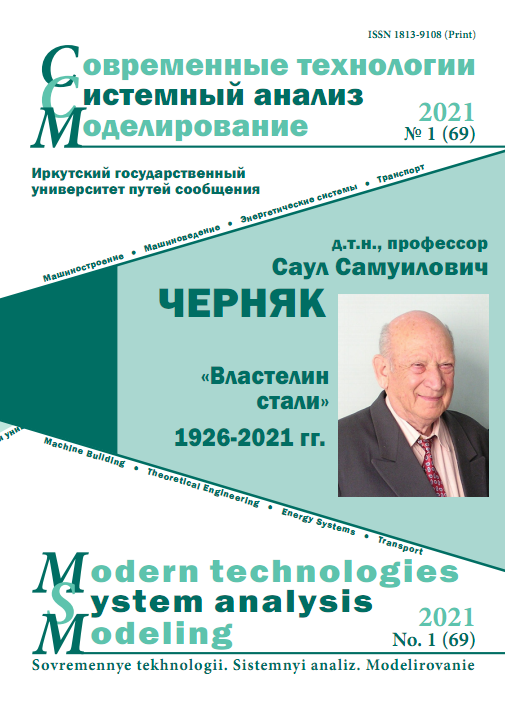Оптимизация инфраструктуры промышленного предприятия с учетом статистического веса объектов
Ключевые слова:
оптимизация промышленного производства, статистический вес объекта, метод наименьших квадратов, оптимизация системы энергоснабжения, система водоотведения, промышленная безопасностьАннотация
В статье выполнен анализ оптимизации промышленного производства на основе метода наименьших квадратов с учетом статистического веса каждого производственного объекта. С использованием данного метода рассмотрена оптимизация системы энергоснабжения и водоотведения, вентиляционной системы и транспортной системы промышленного предприятия. Показано, что при определении статистического веса целесообразно использовать наиболее значимые характеристики объектов. Так, оптимизация системы энергоснабжения промышленного предприятия, использующего в качестве энергоносителя водяной пар, позволила на 18 % снизить потери давления на трение в паропроводе и повысить технико-экономические показатели процесса. Данный результат обусловлен тем, что при расчете статистического веса объекта (аппарата) обоснованно использовалось значение расхода водяного пара в данном аппарате. При этом, чем больше расход пара, тем выше статистический вес объекта. Как показали расчеты, в результате оптимизации системы водоотведения предприятия гидравлическое сопротивление водостока из-за трения снижается на 10 % и, как следствие, повышается его пропускная способность. Оптимизация системы приточной вентиляции на основе метода наименьших квадратов привела к снижению гидравлического сопротивления воздуховода из-за трения на 13 % и снижению затрат мощности на подачу воздуха, при этом статистический вес объекта был поставлен в зависимость от расхода воздуха в конкретном помещении. Метод наименьших квадратов с учетом статистического веса объектов позволил также определить оптимальное расположение пропускных пунктов для персонала промышленного предприятия с целью снижения времени пребывания персонала в опасной зоне. При определении статистического веса каждого объекта в данном случае использовалась численность обслуживающего персонала на объекте: чем выше численность персонала, тем выше статистический вес объекта (цеха). Таким образом, показано, что метод наименьших квадратов с учетом статистического веса объектов является универсальным методом, позволяющим оптимизировать различные аспекты работы промышленного производства.
Библиографические ссылки
Хилл П. Наука и искусство проектирования. М.: Мир, 1973, 263 с.
Gaochen Cui, Qing-Shan Jia, Xiaohong Guan, Qing Liuc. Data-driven computation of natural gas pipeline network hydraulics // Results in Control and Optimization. Volume 1, December 2020, 100004.
Eric Machorro, Jichun Li, Monika Neda, Pengtao Sun, HongtaoYang. Recent advances in computational mathematics and applications // Results in Applied Mathematics. Volume 8, November 2020, 100112.
Jensen H.A., Jerez D.J. A stochastic framework for hydraulic performance assessment of complex water distribution networks // Probabilistic Engineering Mechanics. Vol. 60, April 2020, 103029.
Yusupbekov N.R., Adilov F.T., Ivanyan A.I. Application of Cloud Technologies for Optimization of Complex Processes of Industrial Enterprises // 13th International Conference on Theory and Application of Fuzzy Systems and Soft Computing – ICAFS-2018. Pp. 852–858.
Streltsova E., Borodin A., Yakovenko I., Sokira T., Bizhanova K. Information management system of industrial enterprise in conditions of digitalization // International Journal of Civil Engineering and Technology (IJCIET). Vol. 10. Iss. 01, January 2019. Pp. 559–575.
Сквайрс Дж. Практическая физика. М., 1971, 247 с.
Коломиец Л.В., Поникарова Н.Ю. Метод наименьших квадратов. Самара: Изд-во Самарского университета, 2017. 32 c.
Ахназарова С.Л., Кафаров В.В. Оптимизация эксперимента в химической технологии. М.: Высшая школа, 1978. 319 с.
Лебедева О.А., Гозбенко В.Е., Пыхалов А.А. Мухопад Ю.Ф. Сравнительный анализ методов решения транспортных задач при оптимальном планировании перевозочного процесса // Современные технологии. Системный анализ. Моделирование. 2020. № 3(67). С. 134–139.
Полтавская Ю.О. Оптимизация транспортной сети на основе минимума общих затрат на доставку грузов // Вестник Ангарского государственного технического университета. 2019. № 13. С. 178–183.
Касаткин А.Г. Основные процессы и аппараты химической технологии. М.: Химия, 1973. 753 с.
Павлов К.Ф., Романков П.Г., Носков А.А. Примеры и задачи по курсу процессов и аппаратов химической технологии. Альянс, 2010, 575 с.
Струченков В.И. Дискретная оптимизация. Модели, методы, алгоритмы решения прикладных задач. Москва: СОЛОН-Пр., 2016. 192 с.
Павлов В.П. Карасев Г.Н. Дорожно-строительные машины. Системное проектирование, моделирование, оптимизация. Красноярск: Сиб. федер. ун-т, 2011. 240 c.
Островский Г.М., Волин Ю.М. Методы глобальной оптимизации сложных систем. Москва: ИД МИСиС, 2005. 105 с.
Бабенышев С.В., Матеров Е.Н. Методы оптимизации. Железногорск: Сибирская пожарно-спасательная академия ГПС МЧС России, 2019. 134 с.
Шиплюк. А.Н. Методы оптимизации в задачах аэрогазодинамики. Новосибирск: Изд-во НГТУ, 2014. 107 с.
Золотарев А.А. Методы оптимизации распределительных процессов / А.А. Золотарев. Москва: Инфра-Инженерия, 2014. 160 с.
Авдюнин Е.Г. Моделирование и оптимизация промышленных теплоэнергетических установок. Москва; Вологда: Инфра-Инженерия, 2019.


